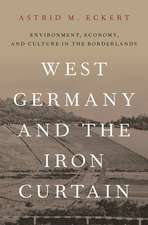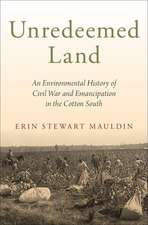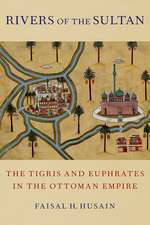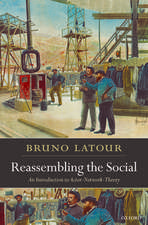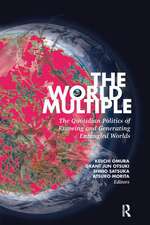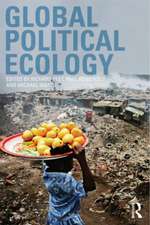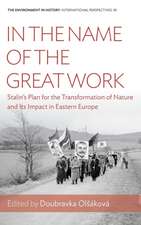Nature Behind Barbed Wire: An Environmental History of the Japanese American Incarceration
Autor Connie Y. Chiangen Limba Engleză Paperback – 22 sep 2020
| Toate formatele și edițiile | Preț | Express |
|---|---|---|
| Paperback (1) | 189.71 lei 22-28 zile | |
| Oxford University Press – 22 sep 2020 | 189.71 lei 22-28 zile | |
| Hardback (1) | 419.15 lei 43-49 zile | |
| Oxford University Press – 27 sep 2018 | 419.15 lei 43-49 zile |
Preț: 189.71 lei
Preț vechi: 257.50 lei
-26%
Puncte Express: 285
Preț estimativ în valută:
33.56€ • 39.02$ • 29.09£
33.56€ • 39.02$ • 29.09£
Carte disponibilă
Livrare economică 12-18 februarie
Preluare comenzi: 021 569.72.76
Specificații
ISBN-13: 9780197533567
ISBN-10: 0197533566
Pagini: 330
Ilustrații: 34 halftones
Dimensiuni: 157 x 234 x 18 mm
Greutate: 0.48 kg
Editura: Oxford University Press
Colecția OUP USA
Locul publicării:New York, United States
ISBN-10: 0197533566
Pagini: 330
Ilustrații: 34 halftones
Dimensiuni: 157 x 234 x 18 mm
Greutate: 0.48 kg
Editura: Oxford University Press
Colecția OUP USA
Locul publicării:New York, United States
Recenzii
A superb explication of the power of place.... Chiang argues the confinement of 120,000 internees is an environmental story as much as a social, legal, or political one.... Nature behind Barbed Wire is vital scholarship because it places the incarceration of Japanese Americans in the arena of social geography and environmental history.
Connie Y. Chiang's Nature Behind Barbed Wire is one of these highly welcome additions to the field. Chiang's book is a pioneering environmental history of the incarceration, offering readers a rich new lens to understand how Japanese Americans and state officials confronted and transformed the pressures of detainment and Japanese American racialization.
The story of Japanese American relocation is a familiar one, but Connie Y. Chiang offers a new perspective, paying particular attention to the evacuees' attitudes, reactions, and achievements. She presents a moving story based upon an exhaustive researchâ. Nature behind Barbed WireÂis a significant contribution to the history of Japanese Americans....Chiang recounts a fascinating story of Japanese American struggle with feeling, sympathy, and compassion.
Nature Behind Barbed Wire is a triumph. It will surely become a staple of environmental history, Asian American history, and Western American history courses.
Nature Behind Barbed Wire offers an insightful and fresh perspective on the subject of Japanese American incarceration. Chiang's deft prose provides a concise narrative throughout, weaving together oral histories, statistical reports, and government memos with skill and clarity. The reframing of Japanese American Incarceration through the lens of environmental history reveals the value in approaching this history with alternative theoretical perspectives.
If ... we separate the environmental degradation caused by humans from what we consider 'nature', we may be guilty of the sort of compartmentalization that facilitates that degradation ... With the Japanese American World War II mass incarceration as an example, Chiang's book is a strong argument for how short-sighted, costly, and cruel this perspective can be ... Chiang's study encompasses everything from the meticulously cared-for pre-World War II farms of Japanese Americans in California, to the dust storms created at the camps because native vegetation had been removed for construction, to the harsh climate and challenging farming conditions of the Desert West where Japanese Americans tried to settle after their release from the camps.
As Connie Chiang has demonstrated in her impressive new book, applying an environmental lens to a familiar narrative
Through fluid prose and engaging stories, Connie Chiang reveals the centrality of nature to the experiences of Japanese Americans incarcerated in War Relocation Authority camps during World War II. [Using three camps as case studies-Manzanar in California, Topaz in Utah, and Minidoka in Idaho-Chiang illustrates that soil, wind, weather, and landscape were important factors in the daily lives of internees and helped to shape their perceptions about themselves, their role in American society, and their place-literally and figuratively-in American democracy. Deeply researched and cogently argued, Nature Behind Barbed Wire requires us rethink our assumptions about this critical period in American history and establishes a new standard for integrating environmental analysis into the study of the past.
In oral history interviews I heard stories of freezing temperatures in the barracks during the winter, unbearable heat in the summer, choking dust storms, back-breaking farm work for little pay, and food shortages. Chiang's very impressive book describes and brings to life the underlying forces and unfortunate decisions that created the hardships so vividly remembered by Japanese Americans incarcerated during World War II.
Connie Chiang's Nature Behind Barbed Wire invites us to consider the wartime removal and imprisonment of Japanese Americans through the lens of the lands on which the events unfolded. We are accustomed to thinking of this tragic episode as a story of human plans and will, but Chiang reminds us that time and again it was the environment that shaped that story's chapters. The book usefully interrupts our familiar patterns of conversation, reminding us that we can imagine and understand this time period in new and revealing ways.
Chiang's book offers a stunningly original perspective. In revealing shared experiences of humans versus nature and humans with nature, it complicates expected narratives of humans versus humans. A welcome bold new approach!
In Nature Behind Barbed Wire, Connie Chiang uses environmental history to offer new information and insights into the impact of wartime confinement on Japanese Americans and on their surroundings. A masterful and eye-opening book.
Connie Y. Chiang's Nature Behind Barbed Wire is one of these highly welcome additions to the field. Chiang's book is a pioneering environmental history of the incarceration, offering readers a rich new lens to understand how Japanese Americans and state officials confronted and transformed the pressures of detainment and Japanese American racialization.
The story of Japanese American relocation is a familiar one, but Connie Y. Chiang offers a new perspective, paying particular attention to the evacuees' attitudes, reactions, and achievements. She presents a moving story based upon an exhaustive researchâ. Nature behind Barbed WireÂis a significant contribution to the history of Japanese Americans....Chiang recounts a fascinating story of Japanese American struggle with feeling, sympathy, and compassion.
Nature Behind Barbed Wire is a triumph. It will surely become a staple of environmental history, Asian American history, and Western American history courses.
Nature Behind Barbed Wire offers an insightful and fresh perspective on the subject of Japanese American incarceration. Chiang's deft prose provides a concise narrative throughout, weaving together oral histories, statistical reports, and government memos with skill and clarity. The reframing of Japanese American Incarceration through the lens of environmental history reveals the value in approaching this history with alternative theoretical perspectives.
If ... we separate the environmental degradation caused by humans from what we consider 'nature', we may be guilty of the sort of compartmentalization that facilitates that degradation ... With the Japanese American World War II mass incarceration as an example, Chiang's book is a strong argument for how short-sighted, costly, and cruel this perspective can be ... Chiang's study encompasses everything from the meticulously cared-for pre-World War II farms of Japanese Americans in California, to the dust storms created at the camps because native vegetation had been removed for construction, to the harsh climate and challenging farming conditions of the Desert West where Japanese Americans tried to settle after their release from the camps.
As Connie Chiang has demonstrated in her impressive new book, applying an environmental lens to a familiar narrative
Through fluid prose and engaging stories, Connie Chiang reveals the centrality of nature to the experiences of Japanese Americans incarcerated in War Relocation Authority camps during World War II. [Using three camps as case studies-Manzanar in California, Topaz in Utah, and Minidoka in Idaho-Chiang illustrates that soil, wind, weather, and landscape were important factors in the daily lives of internees and helped to shape their perceptions about themselves, their role in American society, and their place-literally and figuratively-in American democracy. Deeply researched and cogently argued, Nature Behind Barbed Wire requires us rethink our assumptions about this critical period in American history and establishes a new standard for integrating environmental analysis into the study of the past.
In oral history interviews I heard stories of freezing temperatures in the barracks during the winter, unbearable heat in the summer, choking dust storms, back-breaking farm work for little pay, and food shortages. Chiang's very impressive book describes and brings to life the underlying forces and unfortunate decisions that created the hardships so vividly remembered by Japanese Americans incarcerated during World War II.
Connie Chiang's Nature Behind Barbed Wire invites us to consider the wartime removal and imprisonment of Japanese Americans through the lens of the lands on which the events unfolded. We are accustomed to thinking of this tragic episode as a story of human plans and will, but Chiang reminds us that time and again it was the environment that shaped that story's chapters. The book usefully interrupts our familiar patterns of conversation, reminding us that we can imagine and understand this time period in new and revealing ways.
Chiang's book offers a stunningly original perspective. In revealing shared experiences of humans versus nature and humans with nature, it complicates expected narratives of humans versus humans. A welcome bold new approach!
In Nature Behind Barbed Wire, Connie Chiang uses environmental history to offer new information and insights into the impact of wartime confinement on Japanese Americans and on their surroundings. A masterful and eye-opening book.
Notă biografică
Connie Y. Chiang is Professor of History and Environmental Studies at Bowdoin College. She is the author of Shaping the Shoreline: Fisheries and Tourism on the Monterey Coast.

